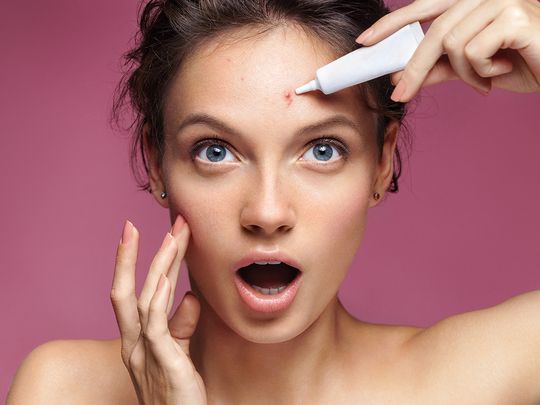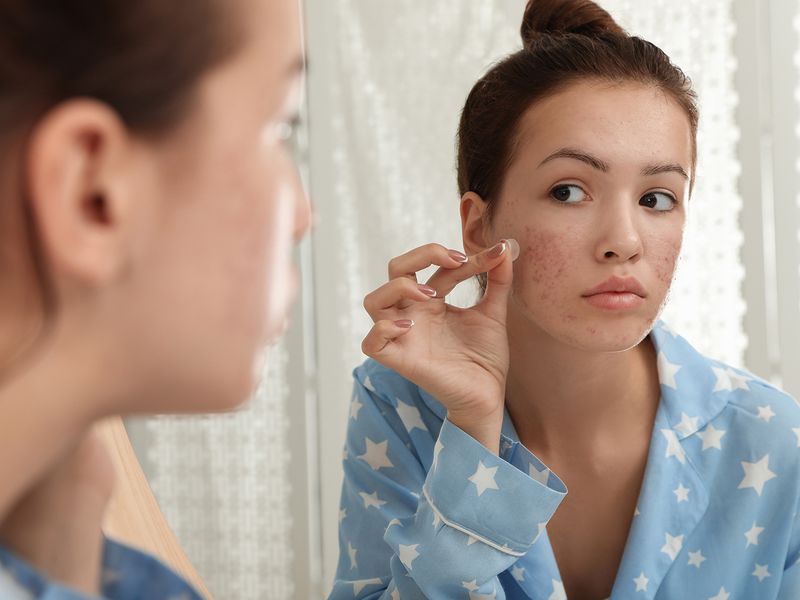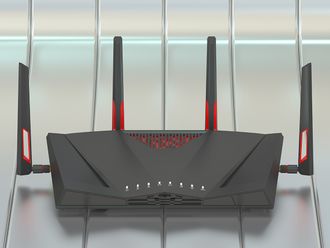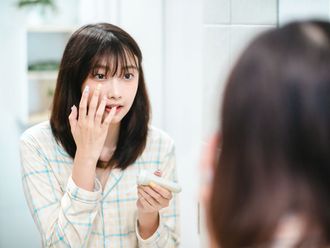
Every woman (and man) has likely experienced this scenario: You wake up on an important day – say your sibling’s wedding, or a class presentation – and find a pimple staring back at you in the mirror. In such situations, what do you reach for, to tackle stubborn acne?
Whether you’ve spent years trying to bring it under control, or have only just started breaking out as an adult, finding the right product is always a daunting task. In fact, caring for acne-prone skin involves well-chosen products, a solid skincare regimen, and a whole lot of patience.
We spoke with Dr Hassan Galadari, dermatologist at Galadari Derma Clinic, Dubai, to get a better understanding of how to treat acne. He said: “The best skincare routine for treating acne typically involves gentle cleansing, exfoliation, and the use of topical treatments.” Scroll below to gain insight into this skin condition, learn about which skincare ingredients work best, and how to effectively treat your breakouts.
Based on our expert’s recommendations, we curated a list of the best acne skincare treatments from Amazon. Adopt one or more of the steps below into your own regimen, to see a visible difference, but do ensure that you consult with a dermatologist for best results. Become a Prime member, and get these products delivered to you as early as tomorrow.
1. Cleanse the skin
If you have acne-prone skin, double-cleansing it may be a good idea, since this helps with degreasing the skin. Bioderma’s Sensibio H2O Micellar Water gently removes impurities like pollution and pollen, and is well-suited to even sensitive skin. Reviewers say they use it to remove make-up as a first step in their skincare routine. Next, follow it up with a gentle face wash, like Paula’s Choice Clear Pore Normalising Cleanser, which contains salicylic acid to fight blackheads and clogged pores, along with panthenol, which soothes the skin and prevents irritation. Another good option is CeraVe’s Acne Foaming Cream Wash, which treats active acne with 10 per cent benzoyl peroxide, but also calms, hydrates and soothes the skin with ingredients like ceramides, hyaluronic acid and niacinamide.
2. Exfoliate and tone
Now that your skin is completely clean, you could add a toner or exfoliating solution. This step further unclogs congested pores, wipes away dead skin and helps remove any residual impurities. La Roche Posay’s Effaclar Clarifying Solution combines glycolic acid, which exfoliates the skin, with 0.5 per cent salicylic acid to help clear pores of blackheads, whiteheads and acne blemishes. Paula’s Choice Skin Perfecting Exfoliant is another bestseller that’s gentle enough for daily use. It features a higher percentage of salicylic acid (two per cent), for deeper penetration into pores, along with green tea extract to calm redness and soothe sensitivity. Some reviewers caution, however, that this potent formula is not suitable for dry skin.
3. Apply a serum
Although not compulsory, by adding an appropriate acne-treating serum to your regimen, you’ll be able to target specific skin concerns. For instance, Caudalie’s Vinopure minimises pores and controls excess oil, by combining salicylic acid with grapeseed antioxidants and essential oils. Another serum, The Ordinary’s popular formula, calms and brightens the skin, and has compelling anti-inflammatory properties. If you’re struggling with scarring and cystic acne, try iS Clinical’s powerful water-based serum, which is a healing formula full of powerful anti-inflammatory and blemish-fighting ingredients, from zinc sulfate and L-ascorbic acid to kojic acid.
4. Spot-treat acne
If you’re not sold on the idea of applying serums, or don’t think you require intensive treatment, consider spot treatments to target occasional acne. Acne Free’s Terminator 10 is ideal for clogged pores that are developing into pimples – it features time-released retinol that works within the skin’s surface to keep keratin from building up and plugging pores. Another bestseller, with over 30,000 4.5-star reviews, is Mario Badescu’s Drying Lotion, which includes salicylic acid, sulfur, zinc oxide and calamine to calm acne overnight.
5. Use a pimple patch
An easy, quick and effective solution to acne, pimple patches are essentially little stickers that remove excess build-up from blemishes. Hero’s Might Patch, for instance, is an unscented hydrocolloid sticker that visibly improves the appearance of pimples within six to eight hours. Reviewers say it’s barely noticeable, thanks to its translucent matte finish, but most prefer putting it on at night, before sleeping. Another option, from K-beauty, is Cosrx’s pimple patch, which also uses as similar hydrocolloid formula, but includes stickers of different sizes for added convenience.
6. Embrace self-care with a face mask
Face masks that fight acne? It’s the perfect way to experience 15 minutes of self-care, and take care of skin concerns. Drunk Elephant’s T.L.C. Sukari Babyfacial uses a powerful blend of AHAs (alpha hydroxy acids) – glycolic, tartaric, lactic and citric acids – to increase cell turnover, while its BHA (beta hydroxy acid), which is salicylic acid, unclogs and minimises the appearance of pores. Another detoxifying face mask, from Kiehl’s, is formulated with Amazonian white clay to draw out pore-clogging oils and toxins, and uses oatmeal and aloe vera to hydrate and shield sensitive skin. Lastly, Peter Thomas Roth’s classic mask uses the tried-and-tested medicinal ingredient, sulfur, to clear up and help prevent acne. Don’t worry, reviewers say there’s none of the foul egg-like scent you’d usually associate with the ingredient.
Why does acne occur?

When our hair follicles become clogged with oil and dead skin cells, it leads to acne. It’s a common skin condition – something people often go through in their teen years.
Dr Galadari explained: “The overproduction of oil, known as sebum, can lead to the growth of bacteria, which causes inflammation and the formation of pimples. There are several types of acne, including whiteheads, blackheads, papules, pustules, nodules, and cysts. Whiteheads and blackheads are non-inflammatory acne, while papules, pustules, nodules, and cysts are inflammatory.”
What’s the best way to treat acne?
Treating acne doesn’t have to be complicated. A good skincare routine is usually gentle, cost-effective and doesn’t overwhelm you with a slew of products or steps. According to Dr Galadari, three factors work best: gentle cleansing, exfoliation, and the use of topical treatments.
He advised: “It's important to use non-comedogenic products that won't clog pores and to avoid harsh ingredients that can irritate the skin. A basic routine may include a gentle cleanser, a non-comedogenic moisturiser, and a topical treatment containing ingredients like benzoyl peroxide, salicylic acid, or retinoids.”
The ingredients Dr Galadari mentions are key to treating pimples and fading scars, since they’re known for their skin renewing properties and their ability to fight acne. He explains the efficacy of each ingredient:
- Salicylic acid: This beta hydroxy acid helps to exfoliate the skin, unclog pores, and reduce inflammation.
- Benzoyl peroxide: This ingredient kills bacteria, reduces inflammation, and helps to unclog pores.
- Retinoids: These vitamin A derivatives help to unclog pores, reduce inflammation, and promote cell turnover, which can help to improve the appearance of acne scars.
By adding them to your skincare regimen, you’ll be more successful at tackling acne and improving the texture and tone of your skin. Our expert added: “It's also important to practice good skincare habits, such as avoiding touching your face, using sunscreen daily, and maintaining a healthy diet, to help keep acne under control.”
What’s the best way to treat acne scars?
For acne scars, in particular, Dr Galadari recommends laser treatments, such as Lumecca IPL (intense pulsed light), which targets pigmented areas and stimulates collagen production to reduce the appearance of acne scars.
Another treatment, Morpheus8, is a “fractional radiofrequency (RF) microneedling device that delivers RF energy deep into the skin through a series of tiny needles. This energy helps to stimulate collagen production and remodel the skin, improving its texture and reducing the appearance of acne scars”.
No matter which option you’d like to explore, however, it’s best to consult with a dermatologist beforehand, to ensure the best treatment for your skin type and specific concerns.
Our recommendations are independently chosen by Gulf News editors. If you decide to shop through links on our website, we may earn an affiliate commission, as we are part of Amazon Services LLC Associates Program.










